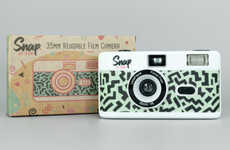
Scientists from the University of Cambridge Created Eco Glitter
Laura McQuarrie — November 12, 2021 — Eco
References: eurekalert.org & designtaxi
Scientists from the University of Cambridge created a sustainable vegan glitter that's made from cellulose (a material found in the cells of plants, vegetables and fruit) rather than microplastic. Unlike the kind of glitter that's so often tucked into greeting cards, decorative ornaments and other festive products, this one is biodegradable and safe for people and the planet. Once the glitter washes off, it can safely make its way back to the earth without causing disruptions as a hazard or pollutant.
To create the vegan glitter, the scientists put cellulose in nanocrystals and put the layer through a structural coloring process. As well as being earth-friendly, the design actually takes cues from the natural world, since the glitter mimics the way butterfly wings glisten.
Image Credit: Benjamin Drouguet
To create the vegan glitter, the scientists put cellulose in nanocrystals and put the layer through a structural coloring process. As well as being earth-friendly, the design actually takes cues from the natural world, since the glitter mimics the way butterfly wings glisten.
Image Credit: Benjamin Drouguet
Trend Themes
1. Eco Glitter - Businesses can create sustainable and biodegradable glitter products using cellulose materials from plants, vegetables, and fruit as a replacement for microplastic.
2. Nanocrystal Technology - Nanocrystal technology can be further developed to create more eco-friendly products that mimic designs and structures in the natural world, such as butterfly wings.
3. Vegan Beauty - The development of vegetable-based glitter creates a new trend for vegan beauty products that are environmentally conscious and safe for people and the planet.
Industry Implications
1. Beauty and Cosmetics - The beauty and cosmetics industry can utilize the technology and materials used in creating eco glitter to make more sustainable products that appeal to environmentally conscious consumers.
2. Arts and Crafts - The arts and crafts industry can develop more eco-friendly glitter products to appeal to consumers who are looking for sustainable and biodegradable alternatives to traditional glitter.
3. Packaging and Printing - The packaging and printing industry can explore nanocrystal technology as a way to create new environmentally friendly ways to add color and design to their products.
5.1
Score
Popularity
Activity
Freshness























